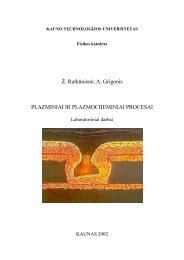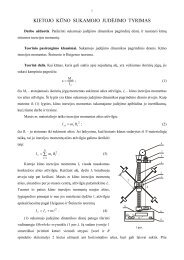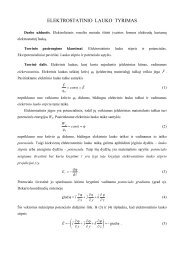PROCEEDINGS OF THE 7 INTERNATIONAL ... - Fizika
PROCEEDINGS OF THE 7 INTERNATIONAL ... - Fizika
PROCEEDINGS OF THE 7 INTERNATIONAL ... - Fizika
Create successful ePaper yourself
Turn your PDF publications into a flip-book with our unique Google optimized e-Paper software.
S. Mattsson / Medical Physics in the Baltic States 7 (2009) 6 - 10<br />
of a single-tube x-ray or by the necessity of rapid tube<br />
current adaptation [5].<br />
Imaging of a given material mixture using dual-source<br />
CT is performed with two X-ray beams of different<br />
effective photon energies. The combined absorption<br />
spectrum of the mixture is sampled at two points of the<br />
energy spectrum. These two data points, together with<br />
a priori knowledge of the mixture’s components and<br />
their relative densities, can be used to determine the<br />
concentration of three materials in each voxel<br />
examined.<br />
CT with flat panel detectors<br />
Large-area flat panel detectors are now more and more<br />
used as an alternative to the conventional CT [6].<br />
Examples of use are 1) routine interventional and<br />
intraoperative imaging using C-arm-based<br />
interventional flat panel detector CT e.g in connection<br />
with brachytherapy, 2) CT image-guided external<br />
tumor therapy, which is one of the fastest growing<br />
applications. Attaching a standard X-ray tube and a flat<br />
panel detector to a rotating linear accelerator allows for<br />
CT imaging of the patient on the therapy couch. The<br />
system is capable of producing images of soft tissue<br />
with good spatial resolution at acceptable imaging<br />
doses [7]. 3) CT for dedicated maxillo-facial scanning<br />
[8] and 4) CT for dedicated imaging of the breast. Last,<br />
but not least, 5) flat panel detector technology has also<br />
been used in standard CTs [9, 10].<br />
The development of the flat panel detector technology<br />
has stimulated much of the developments and research<br />
in 3D imaging. Micro-CT also receives increasing<br />
attention due the interest in molecular and small-animal<br />
imaging.<br />
In external beam radiotherapy, the use of the treatment<br />
beam for imaging is of high interest because this<br />
application requires no additional hardware and the<br />
image obtained gives an exact image of the treatment.<br />
Such imaging has been possible thanks to the<br />
development of electronic portal imaging devices<br />
(EPID). Megavoltage cone beam computed<br />
tomography can be used for treatment planning in 3D<br />
conformal radiotherapy and IMRT, adaptive radiation<br />
therapy, single fraction palliative treatment and for the<br />
treatment of patients with metal prostheses.<br />
2.2.2. Tomosynthesis<br />
Tomosynthesis is a form of limited angle tomography<br />
that produces “slice” images from a series of projection<br />
images acquired as the X-ray tube moves over a<br />
prescribed angular range, typically from – 25 degrees<br />
to + 25 degrees in relation to the angle for the ordinary<br />
projection image. Because the projection images are<br />
not acquired over a full 360° rotation around the<br />
patient, the resolution in the z direction i.e., in the<br />
depth direction perpendicular to the x-y plane of the<br />
projection images is limited. However, the spatial<br />
8<br />
resolution in the x-y plane of the reconstructed slices is<br />
often superior to CT, and the ease of use in conjunction<br />
with conventional radiography makes tomosynthesis a<br />
potentially quite useful imaging modality [11].<br />
3. Molecular imaging<br />
Nuclear medicine or molecular imaging is based on an<br />
i.v. injection, oral administration or inhalation of a<br />
radioactive tracer. Upon administration one awaits<br />
distribution and accumulation of the tracer in the<br />
region of interest, e.g. an organ or a tumour. The<br />
emitted radiation is mapped by a collimator (planar<br />
nuclear medicine and SPECT) or coincidence using<br />
two detectors (PET), 2D or 3D, iterative reconstruction<br />
or filtered back projection, and attenuation correction.<br />
Focus in imaging has changed from structures to a<br />
combination of structures and functions, creating a<br />
renewed interest for nuclear medicine methods, which<br />
can visualise physiologic functions and metabolism in<br />
the human body and also have a potential for molecular<br />
imaging. This will be of high importance for the<br />
advancement of molecular medicine [12], drug<br />
development and delivery techniques [13].<br />
3.1. Planar nuclear medicine<br />
The basic measurement instrument in nuclear medicine<br />
is still the gamma cameras using a NaI(Tl) scintillator<br />
block coupled to an array of photomultiplier tubes. In<br />
recent years there has been a growing interest in<br />
developing compact gamma cameras to improve<br />
nuclear medicine imaging. These are of three types:<br />
1. One or more scintillation crystals coupled to a<br />
single position-sensitive photomultiplier tube<br />
2. A position-sensitive solid-state detector<br />
3. An array of scintillation crystals coupled to an<br />
array of solid-state photo detectors.<br />
Type 1 cameras are expensive, have significant dead<br />
area, and have geometric distortion and non-uniform<br />
gain that can vary with both time and count rate. Type<br />
2 cameras have been under development for over 20<br />
years. The best candidate for room temperature<br />
operation is CdZnTe, a high-atomic-number, solid-state<br />
crystal. However CdZnTe tends to be expensive and is<br />
difficult to manufacture in volumes large enough to<br />
form arrays of useful imaging size. Type 3 cameras<br />
typically use silicon photodiode arrays.<br />
3.2. SPECT<br />
Conventional nuclear medicine images compress the 3dimensional<br />
(3D) distributions of radiotracers into a 2dimensional<br />
image. Tomographic images remove these<br />
difficulties but at the price of longer acquisition times,<br />
poorer spatial resolution, and the susceptibility to<br />
artefacts. Recent advances in SPECT instrumentation








